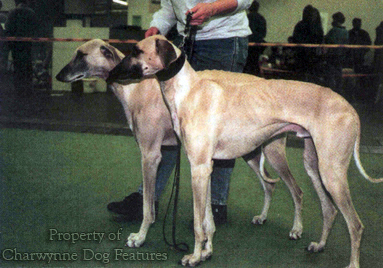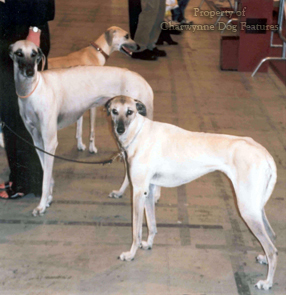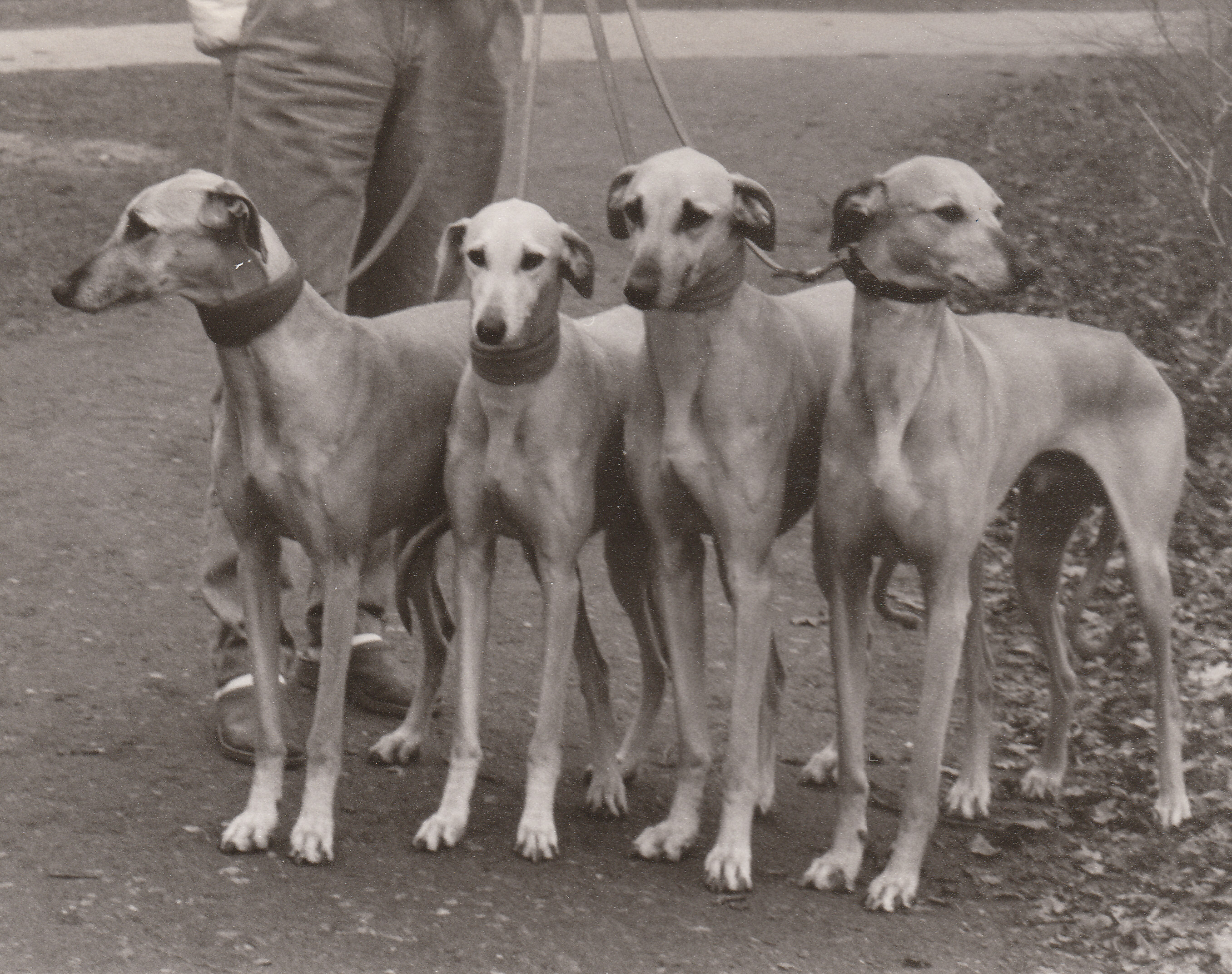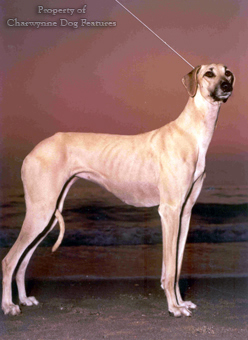739 SIZING UP THE SLOUGHI
SIZING UP THE SLOUGHI
by David Hancock
 For the name of one sighthound breed to sound almost the same as that of a sister breed doesn’t exactly help discussions about the two breeds. And they are now two distinct breeds: in the pedigree world we have smooth and feathered hounds registered as Salukis, with the smooth-coated Sloughi (from North Africa) listed as a separate breed. The Arabs there however referred to them as mogrebi (magreb) or western. The Tuareg Sloughi, sometimes known as the 'oska', is classified separately in some countries as the Azawakh Sloughi, from the valley of that name in Mali and Niger. This can lead to further confusion as the Azawakh and the Sloughi are separate breeds too. Some historians believe that the sighthounds in Eastern Arabia came from Asia originally, possibly with the invading Hyksos. Studies on the blood of the Azawakh and the Sloughi showed that both have an additional allele on the glucose-phosphate-isomerase gene locus not found in other sighthounds and dogs but present in the coyote, fox and jackal. The Sloughi is much more than a smooth Saluki look-a-like.
For the name of one sighthound breed to sound almost the same as that of a sister breed doesn’t exactly help discussions about the two breeds. And they are now two distinct breeds: in the pedigree world we have smooth and feathered hounds registered as Salukis, with the smooth-coated Sloughi (from North Africa) listed as a separate breed. The Arabs there however referred to them as mogrebi (magreb) or western. The Tuareg Sloughi, sometimes known as the 'oska', is classified separately in some countries as the Azawakh Sloughi, from the valley of that name in Mali and Niger. This can lead to further confusion as the Azawakh and the Sloughi are separate breeds too. Some historians believe that the sighthounds in Eastern Arabia came from Asia originally, possibly with the invading Hyksos. Studies on the blood of the Azawakh and the Sloughi showed that both have an additional allele on the glucose-phosphate-isomerase gene locus not found in other sighthounds and dogs but present in the coyote, fox and jackal. The Sloughi is much more than a smooth Saluki look-a-like.
The Moroccan Sahara may well be the last refuge of the true Sloughi, conserved by the nomadic tribesmen of those areas yet unaffected by the remorseless spread of the desert and commercial gazelle-hunting using motorized methods. In the settlements they have been crossed with herding or watchdog types to prevent the ravages of wild pig or jackals. Kennel Clubs separate the breed into two types: the desert type, slender, lightly-built, graceful and elegant, and the mountain type, bigger, stronger, more compact. This has led to a wide height range, from 22” to 28”, although since the breed itself exists in the more remote parts of three sizeable countries: Algeria, Tunisia and Morocco, this is hardly surprising. I have to admit that the first time I saw one, admittedly from a distance, I thought I was seeing a coarsely-bred Greyhound. Then on closer inspection, and after a long most instructive lecture from the handler, I realized that there was, in front of me, a remarkable canine survivor.
As with all hunting dogs bred by primitive people, only the very best were bred from and to become the very best they had to cope with a climate and terrain which could not have been more testing. Now they will have to face ‘urban improvement’, veterinary ‘care’ and its annual inoculations, modern convenience dog food and being bred wholly on appearance, each one an apparent kindness, every one a potential threat. Thankfully, the breed has attracted some sensible level-headed fanciers, keen to perpetuate what is a distinctive and admirable breed of sporting dog. I soon realized the essential differences between this breed and its sister sighthound breeds, the Saluki and more importantly the Azawakh, so similar at a glance, so dissimilar in key details. All three breeds have to run fast – for quite a long time, against their most sought-after quarry – the gazelle family.
 A distinctive feature of the African sighthounds is the prominent haunch bones. Many Arab hunters will automatically place three or four fingers on the four vertebrae between the hook (hip) and pin-bones to assess the hound’s potential for speed in the chase. Sloughis always look shorter bodied than their Saluki cousins and lack the extremely prominent pin-bones of the Azawakh. The Sloughi has an almost level topline and moderate angulation in the hindquarters, with flatter less-bunched muscles than say the Greyhound. Magreb Sloughis tend to move with their heads low, with some show ring judges, more familiar with the flashier breeds, questioning the reason for this. For me it’s a more workmanlike gait. The desert-bred Sloughis can feature more than one type of foot, with a wider cat-foot, unusually for a sighthound breed, now being favoured, with well-arched toes and thick pads. The hocks are set low, and, unlike the Azawakh, the tail is carried low on the move. Their gait looks effortless, harmonious and economical.
A distinctive feature of the African sighthounds is the prominent haunch bones. Many Arab hunters will automatically place three or four fingers on the four vertebrae between the hook (hip) and pin-bones to assess the hound’s potential for speed in the chase. Sloughis always look shorter bodied than their Saluki cousins and lack the extremely prominent pin-bones of the Azawakh. The Sloughi has an almost level topline and moderate angulation in the hindquarters, with flatter less-bunched muscles than say the Greyhound. Magreb Sloughis tend to move with their heads low, with some show ring judges, more familiar with the flashier breeds, questioning the reason for this. For me it’s a more workmanlike gait. The desert-bred Sloughis can feature more than one type of foot, with a wider cat-foot, unusually for a sighthound breed, now being favoured, with well-arched toes and thick pads. The hocks are set low, and, unlike the Azawakh, the tail is carried low on the move. Their gait looks effortless, harmonious and economical.
Our Kennel Club recognizes the breed, describing it as having a dignified bearing, a ‘noble haughtiness’ and an extremely expressive face. Thankfully, it also looks for a racy and strong breed without coarseness and asks for the elongated hare-foot and a long well-developed second thigh, predictably in a sighthound breed. I saw a striking red Sloughi at a World Dog Show a few years ago, with sooty markings on the feet, under the tail and along the tips of the ears, the ‘charbon’ or charcoal coat, strangely being lost in their native country. Not surprisingly, the sandy dogs are favoured in the desert areas and the brindles, often with a black mantle, in the mountains, where they hunt wild pig, the bigger deer and even jackals. I believe some continental enthusiasts have tested their stock at non-commercial racing tracks, as well as using them in lure-coursing. This may not please the purists seeking to preserve a hunting dog but, for me, some use is always better than no use.
I have read accounts linking these impressive hounds with the Phoenicians, who settled in Carthage in North Africa, opposite Sicily, and were the great trading people in the Mediterranean of their time. Whilst they may have brought their Saluki-like hounds with them from the Syria-Lebanon region, I suspect that the Berbers were hunting with hounds way before then, inhabiting the mountains and deserts of North Africa since prehistoric times. I am not suggesting a separate origin for the Sloughi but arguing a history for this type of hunting dog before the Phoenician wanderings. It is however of interest to students of fast hunting dogs that those found in North Africa were drop-eared whilst those on the opposite side of the Mediterranean, from the Spanish islands in the west to the Greek islands in the east, were prick-eared. It could be that the African dogs needed covered ears as protection against sand storms, whereas the southern European hounds used sound much more in the hunting field and benefited from sound-catching bat-like ears in their particular terrain. The latter were however rather more than sighthounds, not just relying on sheer speed and an astonishing ability to spot distant movement, to hunt successfully.
The Sloughi is in Britain but not in favour; 20 were registered in 1981, 21 in 2001 but only 8 in 2010. They look out of place here, with their fine skin, thin smooth coats and spare build; they perhaps belong within sight of the Atlas Mountains rather than the Cairngorms. I find much to admire in the breed and especially their survival into modern times. They thoroughly deserve devoted patronage and their long term future may reside in the south of France, where Moroccans now live in some numbers and seem anxious to conserve their national heritage. Like the Azawakh of Mali, the Sloughi is a victim of the advance of urban living in the region where it evolved; pastoral communities are under threat and nomads losing their ancestral lands.
For lurchermen, this breed is of interest; in their homeland, they are expected to locate, stalk, pursue surreptitiously, then chase and seize their prey, rather than just race after it once sprung. They are never expected to kill their quarry, wounded game often being kept alive to retain its food value over time in a hot demanding climate. Slower than a Greyhound and looking less muscular, the Sloughi has greater stamina and certainly greater robustness in extreme heat. Compared to a Greyhound, the Sloughi is built more on a square than a rectangle and the ears are longer and droopier; white Sloughis are not favoured, but, unlike the Saluki, brindle is. The Saluki has been dubbed the Persian sighthound and the Sloughi the Arab sighthound; despite their obvious similarities, when you see the two breeds side by side, you soon see the two distinct breeds. Sadly, many of these ancient hunting dog breeds will no doubt be lost to us in the coming years and with them will go part of us too.